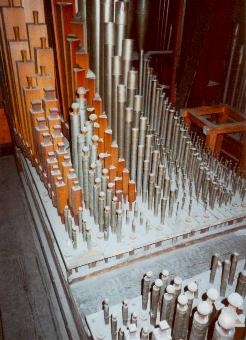 |
C# side of the Great soundboard. Stops are Stopped Diapason, Hohl Flute,
Wald Flute, Octave, Octave Quint, Super Octave, Mixture V, Harmonics IV.
Wind pressure in 4.5".
The wooden frame on the right hand side was support for a water tank.
On another soundboard, over the console, is where the three 8' diapasons
and the trebles of the two 16 stops are located. The reeds stand
in front of the Choir box.
|
 |
C side of the Great reeds Contra Tromba 16, Tromba 8, and Octave
Tromba 4. These stand in front of the Choir box.
Note the dust, and the damaged and collapsing resonators. Wind pressure
for these is 15".
|
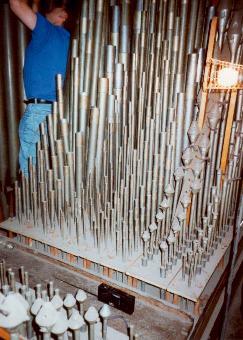 |
The Solo box. John is securing one of the 16' Contra Viola pipes. Behind
him is the c# side of the low pressure section. The two reeds are
Cor Anglais 16' and Orchestral Oboe 8'. Wind pressure for the
flues and these two reeds is 7".
|
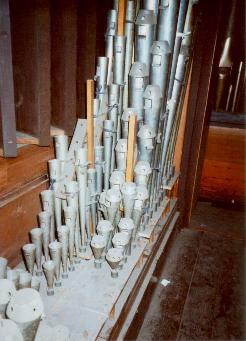 |
On 20" wind the Orchestral Trumpet unit (16 8 4) and the French
Horn. Just visible through the door is part of the Great Organ.
|
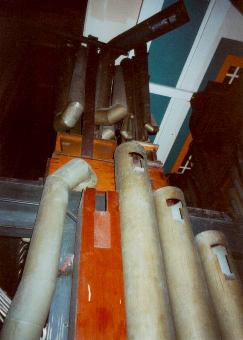 |
The Solo Tuba, which stands in front of the Swell box, seen from the passage
board between the Choir and Great Reeds. It's on 20" wind.
|
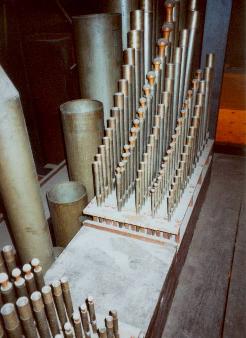 |
The c# side of the Pedal Mixture, which stands immediately behind the
Great. To the left are some of the basses for the Pedal Open Diapason
16 and the Open Wood. The Open Diapason is partly borrowed from the
Great Open Diapason I with 12 pipes to make up the bottom octave. The
mixture would appear to include a couple of stopped ranks, which
would appear to be for the 12th and 17th ranks (5 1/3' and 3 1/5').
|
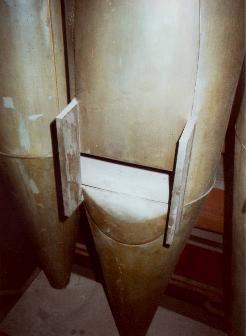 |
Some of the larger pipes of the Open Diapasons are in the case front. Those
which are too large for the height of the middle section are stood off
to one side of the soundboard - in this case one of the 8' Diapason
pipes.
|
 |
Part of the Pedal Mixture action (c side) and the Great stop action seen
from below.
|
 |
Back of the console on the right hand side - part of the combination
action. This side has some water/heat damage. The fixed combination
pistons will bring out the same stops each time (although sometimes
the selection is incomplete), but the adjustable pistons will not
capture some stops, or even the ones you have drawn!
|
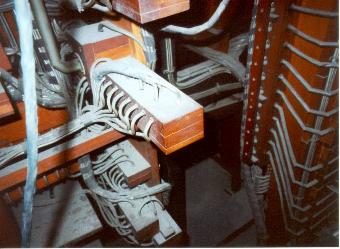 |
Right hand, lower section. On the left some of the damaged combination
action, and part of the Great stop action.
|
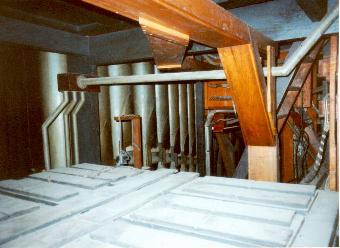 |
Left hand lower section. There is another reservoir above this one,
beneath the choir. On the left at the rear is part of the Pedal
Open Diapason 16 (note the leathered lips).
|
 |
Left hand, lower section - part of the Open Wood ranks (there are two
on the pedal, one at 32' and 16' and the other at 16' and 8'. Also,
a defunct lightbulb. Much of the Pedal is borrowed from the Great. The
only ranks which it has of its own are:
Open Wood I: 16' and 8' (44 pipes)
Open Wood II: 32' and 16' (44 pipes)
Open Diapason: 16 (12 pipes)
Flute: 8' (32 pipes)
Mixture V: 12 15 17 19 22 (160 pipes)
Ophicleide: 32 16 8 (56 pipes)
|
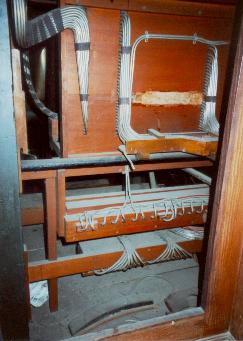 |
Combination action for the Swell and Choir on the left side of
the console.
|
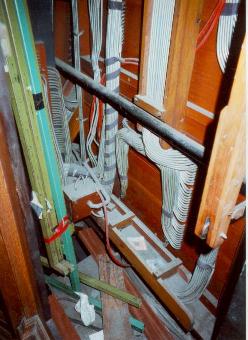 |
The equivalent for the Great, Solo and Pedal at the right hand side
of the console.
|
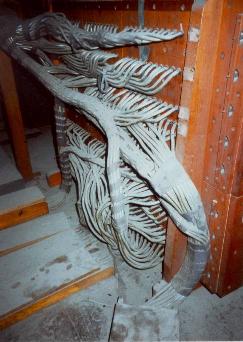 |
More of the same, down below.
|
 |
Low DDD# and CCC# of the Pedal Open Diapason 16'.
|
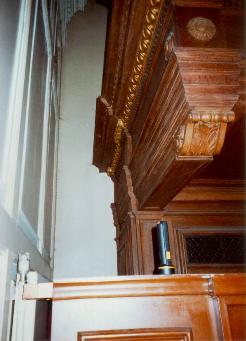 |
What the city residents never see - a detail of the casework. This also
gives some indication of the depth of the case.
|
















